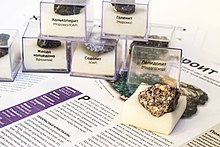Mineral collecting




Mineral collecting is the hobby of systematically collecting, identifying and displaying mineral specimens. Mineral collecting can also be a part of the profession of mineralogy and allied geologic specialties. Individual collectors often specialize in certain areas, for example collecting samples of several varieties of the mineral calcite from locations spread throughout a region or the world, or of minerals found in pegmatites.
History
Generally considered the "father of mineralogy",
Another famous 16th century mineral collector was
Motivations
Mineral collectors find a variety of reasons to collect minerals. Many minerals are strikingly beautiful and collected for their
Specializations
As a collection grows, a collector may become more interested in a particular aspect of mineral collecting. Financial limitations or limitations of physical space can also be motivating factors in specializing a collection. Some specializations include:
- Species collecting; trying to obtain as many recognized species as possible.
- A particular locality such as a mine, country, or state/province.
- A particular mineral species (e.g. calcite, quartz, fluorite) or mineral group (zeolites, phosphate minerals) to show the variety within the species/group.
- A particular geological formation, such as minerals found in pegmatites.
- Fluorescent minerals.
- Radioactive minerals.
- Twinned crystals.
- A particular size range such as (from small to large), micromounts, thumbnail (generally fitting in a 1 inch cube), miniatures, small-cabinet or cabinet sized.
- Collecting only specimens that the collector has collected themselves in the field.
Notable public mineral collections
- Australian Museum, Albert Chapman Mineral Collection], Sydney
- Pittsburgh, Pennsylvania
- Fersman Mineralogical Museum[2] Moscow
- Gallery of Mineralogy and Geology,[3] Paris
- Geological Museum, London[4]
- Houston Museum of Natural Science[5]
- Mercer County District Library] (900 specimens on display) [6]
- Mim Museum (over 1800 specimens representing 450 species on display),[7]Beirut, Lebanon
- Mineralogisches Museum Hamburg (1500 specimens on display)[8]
- École nationale supérieure des mines de Paris, Paris
- Museo Civico di Storia Naturale di Milano, Milan
- National Museum of Natural History, Smithsonian Gem and Mineral Collection, Washington, D.C.
- Natural History Museum of Los Angeles County[9][10]
- Naturhistorisches Museum Wien (Vienna, Austria), Mineralogy and Petrography Exhibition [11]
- Terra Mineralia, Mineral Exhibition of the TU Bergakademie Freiberg, Germany, (3500 specimen on display)[12]
Notable mineral collectors
- Andrew Ketcham Barnett (1852–1914), principal, Penzance School of Mines
- Albert Chapman (1912–1996) after death collection moved to Australian Museum.
- Dr. James S. Douglas (1837–1918), mining engineer. His collection of classic Bisbee minerals was donated to the Smithsonian's National Museum of Natural History.
- mining engineer
- Jack Halpern (collector) (born 1920),[13] collection reviewed in Mineralogical Record [14]
- William W. Jefferis (1820–1906), banker whose vast mineral collection was acquired by the Carnegie Museum of Natural History in 1905
- US Geological Survey(1883–1909)
- William F. Larson (born 1945), Founder of Pala International, board of San Diego Natural History Museum, owner Sinkankas Library [15]
- Gene Meieran (born 1937), 2nd Sr Intel Fellow (after the inventor of the microprocessor),[16] 2003 Carnegie Mineralogical Award winner.[17] Collection also at A. E. Seaman Mineral Museum.
- Morganitewas named after him by G.F. Kunz.
- TU Bergakademie Freiberg, Germany.
- Stephen Smale (born 1930), Professor in mathematics, UC Berkeley. World's best Chinese mineral collection published in book.[20] Appraised Houston Museum of Natural Science collection.
- Abraham Gottlob Werner (1749–1817), pioneering German geologist
- National Museum Wales.
The website of Mineralogical Record magazine includes a Biographical Archive containing biographical sketches of approximately 1,800 (as of 2016) mineral collectors and specimen dealers, most of whom were or are active between the late 19th century and the present day.
See also
- Amateur geology, also called rock collecting or rockhounding
- Fossil collecting
- Lapidary
- Lapidary club
- List of minerals
- Tucson Gem and Mineral Show, the world's largest
- Mineralientage, the Munich Mineral Show, Europe's largest
References
- ^ Frasier, Si and Ann (1995). "The History of Mineral Collecting, 1530-1799". Rocks & Minerals.
- ^ "Минералогический Музей им. А.Е. Ферсмана-крупнейшее собрание минералов в России". www.fmm.ru. Retrieved 2016-07-03.
- ^ "Mineralogy and Geology Gallery", a description page in English, French National Museum of Natural History, official website
- ^ Mineral Collection
- ^ option=com_content&view=article&id=98&Itemid=102 Cullen Hall of Gems and Minerals, Houston
- ^ Ron & Ruth Langsdon Mineral Collection, Celina, Ohio
- ^ www.mim.museum
- ^ Mineral hall, Hamburg
- ^ Hall of Gems and Minerals
- ^ Natural History Museum of Los Angeles; Gems and Minerals. access date: 5/22/2010.
- ^ nhm-wien.ac.at
- ^ terra-mineralia.de Terra Mineralia
- ^ Best of Collectors St. Marie aux Mines page
- ^ Larson, W.F (2005). "A Lucky Man: Jack Halpern and his Colorful Collection". Mineralogical Record: 189–194.
{{cite journal}}: Cite journal requires|journal=(help) - ^ Bio on Mineralogical Record
- ^ Bio of Gene Meieran at Purdue and Intell
- ^ Carnegie Mineralogical Award
- ^ Perkins Sams obituary
- Mineralogical Record
- ^ the book of his collection at Lithographie
Further reading
- Wilson, Wendell (1994). Wilson, Wendell (ed.). The History of Mineral Collecting, 1530-1799. Mineralogical Record. Archived from the original on 2013-03-26. Retrieved 2012-09-29.
External links
- Beginning Guide to Mineral Collecting at mindat.org
- Criteria for selecting crystallized mineral specimens for a display collection by Jack Halpern Reprint article, the Mineralogical Record, 2008
- Tips for collecting minerals in the field, by the Mineralogical Society of America.
- Collector's Corner, at MSA
- The American Federation of Mineral Societies, with links to regional and local clubs in the USA.
![]() Media related to Mineralogy museums at Wikimedia Commons
Media related to Mineralogy museums at Wikimedia Commons
